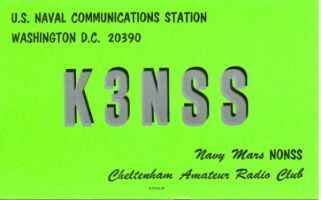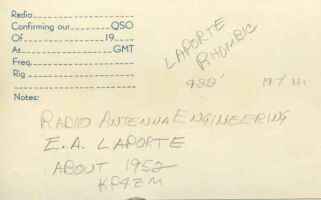

 |
 |
When I first got orders to NAVCOMSTA Washington, DC at Cheltenham, MD in 1978, I really knew nothing about the place, but as it turns out, it really wasn't even a NAVCOMSTA any longer, but had been downgraded to a NAVCOMU. The site at Cheltenham was originally the receiver site for NSS, with the transmitter site at Annapolis, MD, across the river from the US Naval Academy.
I arrived and checked into Cheltenham late at night, so I didn't get a good look at the place till morning. I was pretty excited to see all the antennas, mostly rhombics, all over the place when I got up the next morning. The first day I was there, I began asking around about a ham station, and quickly got access to the club station, K3NSS. Since the NAVCOMMSTA was deactivated as an HF site, the ham station had access to most of the antennas on the site. On the wall was a large drawing of the site with the location and information on the many and various antennas. There were as I recall, 60 some odd rhombics, three or four large fixed vertical log periodics, and a few others, including sector sleeves, fish bones, and so on. In the two weeks I was there, I walked all over the site looking at antennas and taking pictures.
One antenna on the site map was listed as a "Laport Rhombic", which from looking at the map, was some type of stacked array of two rhombics. I did a lot of operating while there, and one night got to talking to KP4ZM in Puerto Rico who it turns out had helped build the Cheltenham antenna farm, and had a lot of personal knowledge of the place. He said that the "Laport Rhombic" was designed to cut down on the multiple sidelobes that all rhombics (actually all long wires) have. This was verified later when I located a copy of Edmudn A. Laport's 1952 book.
The antenna feedlines at Cheltenham were all buried coax. This was similar in electrical size to the old RG-17, and had a protective outer shell of wrapped hemp or jute, making the overall outer dimension about 1.5 or 2 inches. Most of the rhombics had feed lines going to each apex, all coming into the ham shack to one big patch panel. At the antenna, the coax went as far as the base of each apex pole, where there was a broadband balun, with open wire feeders going up the pole to the antenna feedpoint. The balun was in a metal case, and was probably not a ferrite balun, but most likely an air wound balun. According to KP4ZM, this was one of the first large scale uses of buried coaxial feedline at a NAVCOMMSTA.
There was also a giant 78 foot dish antenna at Cheltenham that the Navy had originally used for moon bounce communications experiments in the 60's. This had also been deactivated by the Navy, and had been taken over by the hams for EME work.
The Cheltenham site has been totally deactivated and
abandoned now, but the K3NSS callsign is still held by the Chief of Navy MARS. I'll
be posting some pictures of the Cheltenham antenna farm as I find them and get them scanned.
Select Jim Hawkin's site to see
some excellent pictures and information on the now demolished NSS transmitting site and their
giant VLF antennas. Information and pictures on AMRAD's
VLF experiments
at the NSS site and the ultimate
demolition of NSS's giant
antenna towers are also linked.


